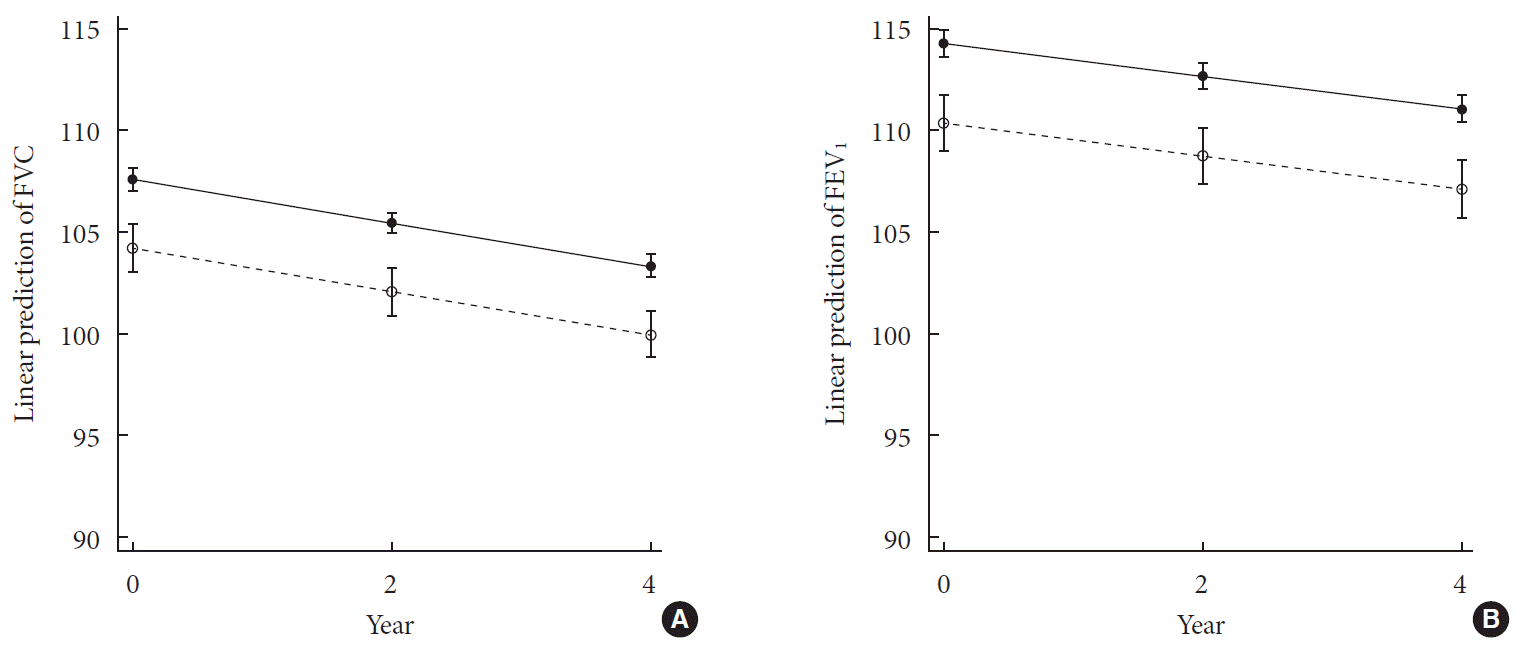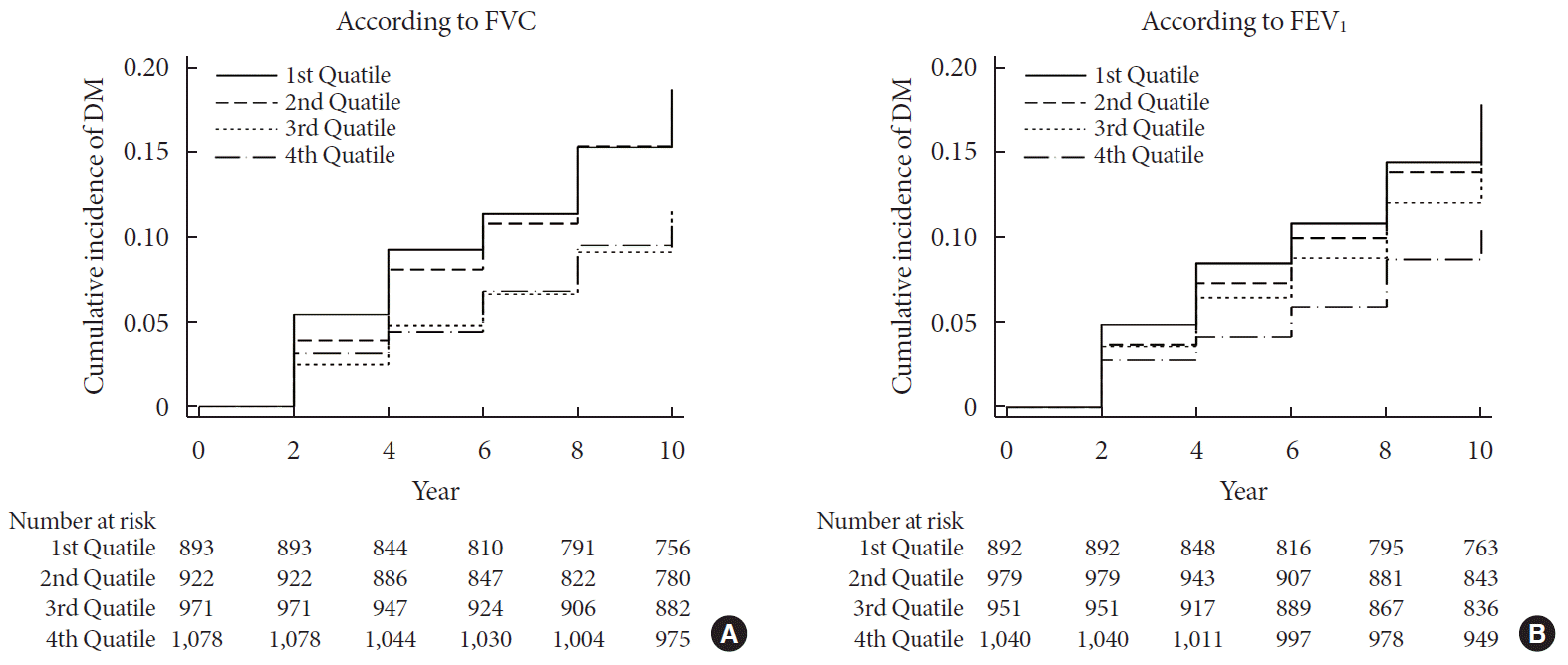INTRODUCTION
METHODS
Subjects
Assessment of clinical characteristics and parameters
Definition of diabetes
Statistics
RESULTS
Baseline characteristics
Table 1.
| Characteristic |
Quartiles of FVC (% predicted) |
Quartiles of FEV1 (% predicted) |
||||||||
|---|---|---|---|---|---|---|---|---|---|---|
| 1st | 2nd | 3rd | 4th | P value/P for trend | 1st | 2nd | 3rd | 4th | P valuea/P for trendb | |
| No. of cases | 1,105 | 1,088 | 1,125 | 1,202 | 1,074 | 1,152 | 1,112 | 1,180 | ||
| Values, % predicted | 86.33±9.15 | 101.68±2.82 | 111.24±2.85 | 126.61±9.39 | 88.63±9.99 | 107.37±3.65 | 119.36±3.39 | 137.61±10.46 | ||
| Age, yr | 55.3±8.8 | 54.5±9.0 | 55.1±8.7 | 56.3±8.6 | <0.001/0.002 | 55.3±8.8 | 54.3±8.8 | 54.6±8.7 | 56.9±8.5 | <0.001/<0.001 |
| Male sex, % | 53.3 | 44.5 | 45.2 | 33.7 | <0.001/<0.001 | 60.6 | 51.8 | 37.9 | 26.8 | <0.001/<0.001 |
| BMI, kg/m2 | 24.68±3.50 | 24.70±3.36 | 24.48±3.10 | 24.28±3.03 | 0.005/<0.001 | 24.21±3.35 | 24.70±3.34 | 24.65±3.13 | 24.53±3.17 | 0.002/0.035 |
| WC, cm | 85.2±9.3 | 84.8±8.8 | 84.5±8.1 | 84.0±8.4 | 0.006/<0.001 | 84.4±8.9 | 85.1±8.6 | 84.8±8.2 | 84.3±8.8 | 0.114/0.564 |
| Hip circumference, cm | 91.7±6.3 | 91.8±6.2 | 91.5±5.8 | 91.1±6.0 | 0.030/0.004 | 91.3±6.1 | 92.0±6.1 | 91.7±5.9 | 91.1±6.2 | 0.002/0.189 |
| WH ratio, % | 0.93±0.06 | 0.92±0.07 | 0.92±0.06 | 0.92±0.06 | 0.044/0.005 | 0.92±0.06 | 0.92±0.07 | 0.92±0.06 | 0.92±0.06 | 0.758/0.815 |
| Met SD, % | 46.0 | 44.9 | 41.0 | 40.5 | 0.015/0.002 | 39.8 | 43.5 | 44.5 | 44.2 | 0.100/0.038 |
| DM at baseline, % | 19.2 | 15.3 | 13.7 | 10.3 | <0.001/<0.001 | 17.0 | 15.0 | 14.5 | 11.9 | 0.007/0.001 |
| SBP, mm Hg | 130.3±18.7 | 130.0±18.9 | 128.4±18.9 | 128.3±19.3 | 0.018/0.001 | 129.7±18.9 | 129.4±18.9 | 129.3±18.8 | 128.4±19.3 | 0.394/0.091 |
| DBP, mm Hg | 84.7±10.9 | 83.8±11.3 | 83.4±11.4 | 82.7±11.5 | 0.001/<0.001 | 84.5±10.9 | 83.7±11.3 | 83.6±11.6 | 82.8±11.4 | 0.006/<0.001 |
| Smoking, % | <0.001/<0.001 | <0.001/<0.001 | ||||||||
| None | 53.2 | 58.7 | 60.4 | 67.2 | 44.4 | 52.9 | 65.5 | 76.1 | ||
| Ex | 15.6 | 11.6 | 12.9 | 10.8 | 15.0 | 15.0 | 12.0 | 9.2 | ||
| Light | 11.2 | 11.2 | 11.3 | 10.0 | 14.3 | 12.2 | 10.6 | 6.7 | ||
| Heavy | 20.0 | 18.5 | 15.4 | 12.0 | 26.3 | 19.9 | 11.9 | 8.0 | ||
| Exercise, % | 0.028/0.005 | 0.053/0.028 | ||||||||
| None | 77.0 | 79.2 | 79.0 | 81.7 | 79.2 | 77.2 | 78.6 | 82.2 | ||
| 1–3/wk | 12.4 | 11.4 | 13.3 | 11.1 | 11.7 | 12.6 | 12.9 | 11.0 | ||
| 4–7/wk | 10.6 | 9.4 | 7.7 | 7.2 | 9.1 | 10.2 | 8.5 | 6.8 | ||
| FBS, mg/dL | 88.8±23.9 | 85.9±14.4 | 85.4±19.2 | 83.3±13.2 | <0.001/<0.001 | 87.6±22.4 | 86.5±17.1 | 85.4±18.2 | 84.0±14.3 | <0.001/<0.001 |
| Fasting insulin, µU/mL | 7.71±4.36 | 8.52±5.84 | 8.29±6.53 | 8.06±5.44 | 0.008/0.569 | 7.48±4.43 | 8.26±5.74 | 8.44±5.55 | 8.35±6.42 | <0.001/<0.001 |
| HbA1c, % | 5.98±1.07 | 5.85±0.90 | 5.82±0.93 | 5.75±0.88 | <0.001/<0.001 | 5.94±1.06 | 5.86±0.91 | 5.81±0.93 | 5.78±0.88 | <0.001/<0.001 |
| HOMA-IR | 1.76±1.99 | 1.82±1.31 | 1.77±1.51 | 1.67±1.22 | 0.132/0.122 | 1.65±1.18 | 1.81±2.00 | 1.80±1.31 | 1.75±1.45 | 0.074/0.039 |
| Total cholesterol, mg/dL | 188.6±36.6 | 186.2±35.1 | 185.9±33.1 | 183.6±34.0 | 0.008/<0.001 | 185.0±35.2 | 186.4±34.2 | 186.6±35.1 | 186.1±34.6 | 0.723/0.765 |
| Triglyceride, mg/dL | 173.8±111.6 | 165.4±107.4 | 165.9±112.5 | 157.9±100.1 | 0.006/0.001 | 168.7±107.3 | 171.4±116.3 | 163.8±101.7 | 159.2±105.7 | 0.033/0.008 |
| HDL-C, mg/dL | 44.4±10.3 | 44.3±10.1 | 44.7±10.3 | 44.5±9.9 | 0.861/0.495 | 44.9±10.5 | 43.8±10.1 | 44.5±9.8 | 44.7±10.1 | 0.051/0.761 |
| AST, IU/L | 32.5±30.8 | 30.5±16.2 | 30.0±13.1 | 28.2±12.9 | <0.001/<0.001 | 32.4±28.2 | 30.8±20.5 | 29.2±15.3 | 27.7±10.5 | <0.001/<0.001 |
| ALT, IU/L | 30.0±27.8 | 28.9±27.8 | 26.8±18.5 | 24.4±13.4 | <0.001/<0.001 | 29.1±22.6 | 29.5±25.8 | 27.3±26.3 | 24.1±13.6 | <0.001/<0.001 |
| Creatinine, mg/dL | 0.84±0.20 | 0.82±0.21 | 0.81±0.15 | 0.78±0.13 | <0.001/<0.001 | 0.84±0.20 | 0.83±0.21 | 0.80±0.15 | 0.77±0.13 | <0.001/<0.001 |
| WBC, ×103/mL | 6.64±1.82 | 6.52±1.83 | 6.36±1.79 | 6.26±1.82 | <0.001/<0.001 | 6.74±1.85 | 6.53±1.80 | 6.37±1.84 | 6.14±1.74 | <0.001/<0.001 |
| CRP, mg/dL | 0.29±0.74 | 0.23±0.39 | 0.26±0.83 | 0.22±0.50 | 0.448a/0.216 | 0.25±0.47 | 0.28±0.77 | 0.26±0.84 | 0.22±0.36 | 0.417a/0.318 |
Values are presented as mean±standard deviation.
FVC, forced vital capacity; FEV1, forced expiratory volume in 1 second; BMI, body mass index; WC, waist circumference; WH, waist hip; Met SD, metabolic syndrome standard deviation; DM, diabetes mellitus; SBP, systolic blood pressure; DBP, diastolic blood pressure; FBS, fasting blood sugar; HbA1c, glycosylated hemoglobin; HOMA-IR, homeostasis model assessment of insulin resistance; HDL-C, high-density lipoprotein cholesterol; AST, aspartame aminotransferase; ALT, alanine aminotransferase; WBC, white blood cell; CRP, C-reactive protein.
Table 2.
| Factor |
FVC |
FEV1 |
||||||||||
|---|---|---|---|---|---|---|---|---|---|---|---|---|
|
Univariate |
Multivariatea |
Univariate |
Multivariatea |
|||||||||
| Beta-coeff | SE | P value | Beta-coeff | SE | P value | Beta-coeff | SE | P value | Beta-coeff | SE | P value | |
| Age, yr | 0.108 | 0.028 | <0.001 | 0.149 | 0.03 | <0.001 | 0.192 | 0.033 | <0.001 | 0.236 | 0.035 | <0.001 |
| Male sex | –4.461 | 0.484 | <0.001 | –3.951 | 0.842 | <0.001 | –10.843 | 0.558 | <0.001 | –6.863 | 0.972 | <0.001 |
| BMI, kg/m2 | –0.243 | 0.075 | 0.001 | –0.218 | 0.082 | 0.008 | 0.205 | 0.089 | 0.021 | 0.013 | 0.095 | 0.890 |
| WC, cm | –0.094 | 0.028 | 0.001 | –0.008 | 0.033 | 0.806 | ||||||
| Hip circumference, cm | –0.109 | 0.040 | 0.006 | –0.058 | 0.047 | 0.221 | ||||||
| WH ratio, % | –7.801 | 3.870 | 0.044 | 5.205 | 4.603 | 0.258 | ||||||
| SBP, mm Hg | –0.036 | 0.013 | 0.005 | –0.034 | 0.014 | 0.013 | –0.010 | 0.015 | 0.490 | –0.038 | 0.016 | 0.018 |
| DBP, mm Hg | –0.087 | 0.021 | <0.001 | –0.071 | 0.025 | 0.005 | ||||||
| Smoking | ||||||||||||
| Ex | –3.419 | 0.751 | <0.001 | 0.793 | 0.986 | 0.421 | –8.399 | 0.867 | <0.001 | –2.041 | 1.138 | 0.073 |
| Light | –1.985 | 0.801 | 0.013 | 1.404 | 0.976 | 0.150 | –9.469 | 0.924 | <0.001 | –3.587 | 1.127 | 0.001 |
| Heavy | –4.016 | 0.679 | <0.001 | 0.349 | 0.961 | 0.716 | –12.095 | 0.783 | <0.001 | –4.600 | 1.109 | <0.001 |
| Exercise, /wk | ||||||||||||
| 1–3 | –0.521 | 0.750 | 0.487 | –0.719 | 0.891 | 0.419 | ||||||
| 4–7 | –2.614 | 0.867 | 0.003 | –2.348 | 1.032 | 0.023 | ||||||
| FBS, mg/dL | –0.091 | 0.014 | <0.001 | –0.084 | 0.016 | <0.001 | ||||||
| Fasting insulin, μU/mL | 0.046 | 0.044 | 0.301 | 0.170 | 0.052 | 0.001 | ||||||
| HbA1c, % | –1.359 | 0.255 | <0.001 | –1.244 | 0.264 | <0.001 | –1.261 | 0.303 | <0.001 | –1.354 | 0.305 | <0.001 |
| HOMA-IR | –0.221 | 0.163 | 0.175 | 0.233 | 0.193 | 0.229 | ||||||
| Total cholesterol, mg/dL | –0.019 | 0.007 | 0.007 | –0.017 | 0.007 | 0.020 | 0.011 | 0.008 | 0.182 | –0.004 | 0.009 | 0.610 |
| Triglyceride, mg/dL | –0.008 | 0.002 | 0.001 | 0.002 | 0.002 | 0.377 | –0.007 | 0.003 | 0.005 | 0.003 | 0.003 | 0.232 |
| HDL-C, mg/dL | 0.005 | 0.024 | 0.824 | 0.013 | 0.028 | 0.643 | ||||||
| AST, IU/L | –0.067 | 0.012 | <0.001 | –0.065 | 0.020 | 0.001 | –0.086 | 0.015 | <0.001 | –0.068 | 0.023 | 0.003 |
| ALT, IU/L | –0.061 | 0.011 | <0.001 | 0.012 | 0.018 | 0.492 | –0.069 | 0.013 | <0.001 | 0.036 | 0.020 | 0.076 |
| Creatinine, mg/dL | –11.016 | 1.355 | <0.001 | –6.004 | 1.521 | <0.001 | –17.714 | 1.600 | <0.001 | –5.396 | 1.756 | 0.002 |
| WBC, ×103/mL | –0.618 | 0.133 | <0.001 | –0.260 | 0.141 | 0.065 | –1.220 | 0.157 | <0.001 | –0.588 | 0.163 | <0.001 |
| CRP, mg/dL | –0.884 | 0.379 | 0.020 | –0.674 | 0.377 | 0.074 | –0.750 | 0.451 | 0.096 | –0.338 | 0.435 | 0.437 |
FVC, forced vital capacity; FEV1, forced expiratory volume in 1 second; Beta-coeff, beta-coefficient; SE, standard error; BMI, body mass index; WC, waist circumference; WH, waist hip; SBP, systolic blood pressure; DBP, diastolic blood pressure; FBS, fasting blood sugar; HbA1c, glycosylated hemoglobin; HOMA-IR, homeostasis model assessment of insulin resistance; HDL-C, high-density lipoprotein cholesterol; AST, aspartame aminotransferase; ALT, alanine aminotransferase; WBC, white blood cell; CRP, C-reactive protein.
Incident diabetes
Table 3.
| Variable |
FVC |
FEV1 |
||||
|---|---|---|---|---|---|---|
| 1st | 2nd | 3rd | 1st | 2nd | 3rd | |
| Univariate | 1.751 (1.385–2.213) | 1.665 (1.316–2.106) | 1.043 (0.807–1.349) | 1.772 (1.389–2.261) | 1.592 (1.248–2.032) | 1.421 (1.106–1.826) |
| Model 1a | 1.623 (1.277–2.064) | 1.568 (1.234–1.993) | 1.034 (0.797–1.341) | 1.675 (1.299–2.161) | 1.470 (1.142–1.893) | 1.426 (1.105–1.841) |
| Model 2b | 1.389 (1.092–1.768) | 1.390 (1.092–1.768) | 1.016 (0.783–1.318) | 1.452 (1.124–1.877) | 1.358 (1.053–1.751) | 1.430 (1.108–1.846) |
| Model 3c | 1.408 (1.106–1.793) | 1.381 (1.084–1.759) | 1.025 (0.790–1.330) | 1.469 (1.137–1.898) | 1.334 (1.034–1.722) | 1.449 (1.122–1.870) |
Hazard ratios and 95% confidence intervals in parentheses were presented, using the 4th quartile group as a reference group.
FVC, forced vital capacity; FEV1, forced expiratory volume in 1 second.
Comparison of FVC and FEV1 reductions according to diabetes development
 | Fig. 2(A) Forced vital capacity (FVC) (% predicted) and (B) forced expiratory volume in 1 second (FEV1) (% predicted) according to diabetes mellitus (DM) development and time. Markers represents mean values at each time, and vertical lines represent 95% confidential intervals. Solid line with circle marker represents non-DM progressors, and dashed line with hollow circle marker represents DM progressors. |
Panel HOMA-IR results according to quartiles of FVC (% predicted)
Table 4.
| Variable |
FVC |
FEV1 |
||||||
|---|---|---|---|---|---|---|---|---|
|
Univariate |
Multivariate |
Univariate |
Multivariate |
|||||
| Coefficients (95% CI) | P valuea | Coefficients (95% CI) | P valueb | Coefficients (95% CI) | P valuea | Coefficients (95% CI) | P valueb | |
| 1st | 0.095 (0.010 to 0.180) | 0.028 | 0.129 (0.044 to 0.215) | 0.003 | 0.003 (–0.083 to 0.089) | 0.944 | 0.064 (–0.024 to 0.153) | 0.156 |
| 2nd | 0.127 (0.044 to 0.210) | 0.003 | 0.139 (0.055 to 0.223) | 0.001 | 0.790 (–0.004 to 0.162) | 0.061 | 0.114 (0.029 to 0.199) | 0.009 |
| 3rd | 0.018 (–0.064 to 0.100) | 0.661 | 0.044 (–0.039 to 0.126) | 0.298 | 0.036 (–0.047 to 0.119) | 0.396 | 0.045 (–0.038 to 0.129) | 0.290 |




 PDF
PDF Citation
Citation Print
Print




 XML Download
XML Download